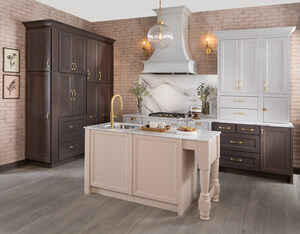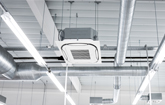Save Money Through Energy Efficiency
MISSION, Kan., Aug. 21, 2017 /PRNewswire/ -- (Family Features) As much as half of the average homeowner's monthly utility expenses go toward cooling and heating, according to the U.S. Department of Energy (DOE). For many households, that makes energy the largest home-related expense each month, next to a mortgage payment.
Fortunately, numerous technological advances are making it easier than ever to manage home energy use. In fact, the DOE estimates you can save as much as 10 percent a year on energy costs by simply adjusting the temperature up or down when you're away during the day. Installing a programmable thermostat that never forgets to adjust on a busy morning and kicks back on before you arrive home can help you earn these savings and reduce energy consumption.
Home Automation
Newer smart, programmable thermostats can be controlled remotely by internet-connected devices, such as tablets and smartphones. Some models can also monitor your energy usage and system efficiency, providing data to help you make further adjustments to how you operate your HVAC system.
Lighting is another major energy challenge. However, smart light bulbs let you adjust your home's ambiance (and energy usage) with just a couple of quick taps. Paired with motion sensors that detect movement (or a lack thereof) and adjust lighting accordingly, smart bulbs can help reduce the waste of energy caused by lighting unused rooms.
Similarly, smartphone applications that connect to other appliances, utilities and home features offer the best of personalized comfort and convenience while providing tools to help minimize your home's energy consumption.
Zoned Climate Control
If you're like most homeowners, there are parts of your house that simply don't get much use or only get used during certain times of the day. Maintaining the temperature in those uninhabited areas can be costly and wasteful. As an alternative, an option such as zoned climate control allows you to stay comfortable in the rooms you use without spending a fortune on energy bills.
While a zoned system is generally considered a premium home feature, it isn't unattainable and actually offers long-term savings, due to its energy-efficient operation. The home is divided into zones, designated by floors, rooms or areas – however the homeowner chooses – which eliminates the "all on" feature of traditional air conditioners.
A system like Mitsubishi Electric Cooling & Heating's Zoned Comfort Solutions offers a true zoning-system with convenient controls and automation, along with whisper-quiet operation. Both ducted and non-ducted units are available depending on the space and occupant needs. Additionally, some models have advanced filtration features to help eliminate allergens, contributing to improved air quality.
For a new build, installing a zoned system from the outset is relatively simple. However, zoned systems are also a possible solution for replacing your home's HVAC system or rectifying a problem with a single uncomfortable room. Pairing the system with sensors or remote app controls can bring operating costs even lower through computerized automation.
Renewable Energy
Another option to offset some of your home's energy and utility costs is generating your own renewable energy through solar or wind power systems. Installation depends on many variables, such as how much energy you use, local codes and standards, and whether the house and surrounding terrain are situated to allow you to capture adequate natural power. For a home under construction, your builder should be able to offer guidance; for an existing home, contacting a local renewable energy organization or state office is a smart first step.
Find more ways to save money on your energy bill at mitsubishicomfort.com.
Cost Control
A state-of-the-art zoned climate control system can be configured to your specific needs, but all the customization options can make it tricky to predict how much your installation might cost. Taking into account these variables can give you a better sense of how much you'll be spending.
New equipment. Each system includes an outdoor unit, indoor unit(s), controls and parts including the refrigerant line-set, wiring and electrical accessories. Conditioning one room or zone comes at a significantly different price than cooling and heating a home with eight or more zones. Generally, new equipment comes in between $3,000-$15,000, depending on the number of zones and size of the home.
Labor. This is what you will pay a licensed HVAC contractor to install the system (and remove your old one, if necessary). Contractors' labor prices vary widely, but expect to spend an amount roughly equal to your equipment cost, depending on your geographic location and the complexity of the installation.
Additional costs. Depending on your existing system, you may incur costs for items such as electrical work to install a new 240V outlet ($200-$1,000, or more if your electrical panel requires a new circuit); an equipment pad, stand or brackets for the outdoor unit ($50-$300); ductwork (prices vary greatly depending on the home); and controller options (approximately $200-$300 each).
Unique situations. Some homes, such as older homes, high-performance homes and homes in extreme cold-weather regions, often require auxiliary heat or specialized designs or equipment, all of which can impact the cost of the system. However, with Mitsubishi Electric's Zoned Comfort Solutions, 100 percent heating down to a 5 F outdoor temperature can be attained.
Rebates. Some states offer rebates for the installation of more energy-efficient appliances, including HVAC systems. These rebates can help offset some of the upfront costs associated with installing zoned systems. Consider speaking with a professional or researching available rebates in your region before purchasing a new system.
Michael French
[email protected]
1-888-824-3337
editors.familyfeatures.com
About Family Features Editorial Syndicate
Established in 1974, Family Features is a leading provider of free food and lifestyle content for print and online publications. Our articles, photos, videos and web content solutions save you time, money and help create advertising opportunities. Registration is fast and free – with absolutely no obligation. Visit editors.familyfeatures.com for more information.
SOURCE Family Features Editorial Syndicate
Related Links
WANT YOUR COMPANY'S NEWS FEATURED ON PRNEWSWIRE.COM?
Newsrooms &
Influencers
Digital Media
Outlets
Journalists
Opted In






Share this article